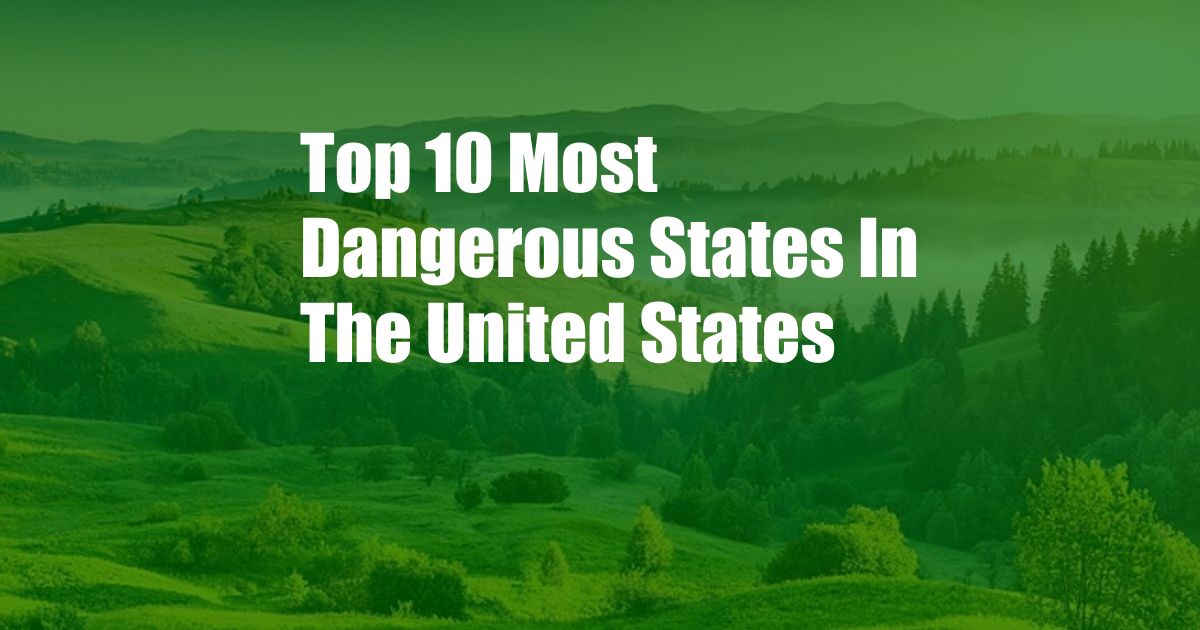
The Perilous States: Exploring America’s Most Dangerous Regions
In the tapestry of the United States, a somber thread weaves its way through select states, where crime, violence, and fear cast a long shadow over communities. From the bustling metropolises to rural outposts, the scourge of peril lurks, leaving an indelible imprint on the lives of its inhabitants. In this exposé, we embark on a harrowing journey, unveiling the top 10 most dangerous states in America.
A Sobering Reality: America’s Hotbeds of Crime
The grim statistics paint a disheartening picture of the most dangerous states, where violence erupts like wildfire and safety is a coveted luxury. According to the FBI’s Uniform Crime Reporting Program, Louisiana, Mississippi, Alabama, Missouri, South Carolina, Arkansas, Oklahoma, New Mexico, Kentucky, and Georgia consistently rank among the top states for violent crime, property crime, and overall crime.
These states grapple with a myriad of factors that fuel their dangerous reputation. Poverty, inequality, lack of economic opportunities, and inadequate social services create a fertile breeding ground for crime. The illicit drug trade, gang activity, and firearms proliferation further exacerbate the problem, leaving citizens feeling vulnerable and fearful in their own communities.
A Deeper Dive into the Perils
Louisiana: The “Bayou State” lives up to its reputation as one of the most perilous states in the nation. New Orleans, its infamous metropolis, is plagued by a rampant murder rate and violent crime. Poverty, drug trafficking, and a legacy of corruption have left an indelible scar on the city and its people.
Mississippi: Dubbed the “Magnolia State,” Mississippi is a breeding ground for crime. The state’s chronically low income levels, coupled with limited job opportunities, have created an environment conducive to violence. Property crime is also a prevalent issue, with theft and burglaries plaguing communities.
Alabama: Known as the “Heart of Dixie,” Alabama’s crime problem stems from a combination of poverty, underfunded law enforcement, and a proliferation of firearms. Violent crime rates are alarmingly high, with Birmingham being particularly notorious for its murder rate. Drug-related offenses also contribute to the state’s dangerous reputation.
Missouri: The “Show-Me State” is no laughing matter when it comes to crime. St. Louis, its largest city, has consistently ranked among the most dangerous cities in the nation. Gang violence, drug trafficking, and poverty are the primary drivers of the city’s high crime rates.
Expert Insights and Practical Advice
Tips from Law Enforcement Experts:
- Be aware of your surroundings and trust your instincts.
- Avoid isolated areas, especially at night.
- Lock your doors and windows, even when you’re home.
- Report suspicious activity to the police immediately.
- Build relationships with your neighbors and local law enforcement.
Advice Based on Blogger Experience:
- Consider investing in a home security system or alarm.
- Join neighborhood watch programs or community organizations.
- Support initiatives aimed at reducing crime and improving social conditions.
- Encourage a culture of respect and empathy within your community.
Frequently Asked Questions
Q: What factors contribute to high crime rates in certain states?
A: Poverty, inequality, lack of economic opportunities, inadequate social services, illicit drug trade, gang activity, and firearms proliferation are major contributing factors.
Q: Which cities are considered the most dangerous in the United States?
A: New Orleans, St. Louis, Birmingham, Jackson, Memphis, Baltimore, and Detroit are consistently ranked among the most dangerous cities.
Q: What can be done to address high crime rates?
A: A comprehensive approach is required, investing in social programs, improving economic opportunities, increasing law enforcement resources, and addressing the root causes of crime.
Conclusion
The grim reality of crime-ridden states is a stark reminder of the challenges facing our society. While the statistics may be disheartening, they also serve as a clarion call for action. By addressing the underlying causes of crime, empowering communities, and promoting a culture of respect and safety, we can strive to make our neighborhoods, cities, and states safe havens for all.
Are you concerned about the safety of your community? Share your thoughts and experiences in the comment section below.